Primatologist Martin Kowalewski is measuring the scale of the fires raging across Latin America not in satellite images, but in the number of caraya monkeys (black-and-gold howlers) that have succumbed to the flames.
“Of the 20 family groups that we used to trace in the wild, each group consisting of seven or eight monkeys, at least five groups were burned alive,” he tells the Guardian. Other animals have also perished at San Cayetano, a nature reserve in Argentina’s northeastern province of Corrientes. “Carpinchos (giant South American rodents), otters, two species of fox, guazu deer, yacare caimans, turtles, snakes. Birds are better at escaping the fire, but that was before all the deforestation. Now they have nowhere to go because there is nowhere else. The forest is so fragmented that they have nowhere to nest.”
Argentina, Brazil, Paraguay and Bolivia this year have seen a raging tsunami of fires, in what may become the longest and most destructive environmental crisis faced by the four neighbouring countries.
The main areas affected are the Gran Chaco forest that straddles Argentina, Bolivia and Paraguay, the Brazilian and Bolivian Amazon, the Pantanal wetlands shared by Brazil and Paraguay, and Argentina’s vast Parana Delta wetlands.

In Argentina, half of the country’s 23 provinces are enduring the worst fires in decades, causing sore eyes and breathing difficulties in a number of smoke-invaded cities, while destroying wildlife – from endangered monkeys to jaguars, as well as birds and reptiles. Parts of its heavily deforested northern Gran Chaco are burning, as are the country’s eastern Parana Delta wetlands, where fires skip from one cattle-grazing island to the next, forming gigantic walls of flame.
In Paraguay a national emergency was declared on 1 October as more than 12,000 outbreaks were recorded and the capital, Asuncion, choked on dense smoke. Wildfires in the Paraguayan Gran Chaco forest have been so extensive that last weekend’s newspapers ran front-page stories with such headlines as “Paraguay burns”, “In between flames” and “Help! Somebody help us”.
Omar Cabanellas, mayor of the Chaco town of General Bruguez, says a local man died in “totally uncontrollable” fires that affected nearly 600 square miles. “It completely overwhelmed us,” he says. “There were dead wild animals everywhere. The ranches are totally burnt.”
The fires are also rampant in Bolivia, the land-locked nation next to Brazil, Argentina and Paraguay, home to extensive areas of the Amazon and Gran Chaco forests. On 16 September, Bolivia declared a state of emergency because of widespread fires, fanned by strong winds and temperatures above 45C. Government estimates the loss up to September 2020 at about 2,400 square miles.
Fires in Brazil’s Amazon are the worst in a decade, satellite data has shown, driven by high levels of deforestation, mostly to make way for cattle pasture and soy plantations, two commodities that have grown in value during the pandemic. As much as 40% of the Brazilian Amazon is nearing the tipping point of turning from forest into savannah. Further south, more than a quarter of the Pantanal, the world’s largest tropical wetlands, has been on fire this year, a combination of arson and drought driven by the climate crisis.
“We sleep breathing smoke and wake up breathing smoke,” Laura Ferreira da Silva of the Quilombo Mata Cavalo community, which was founded by escaped slaves, tells the Guardian.
In all four countries the fires have been driven by a number of forces, but particularly the extensive deforestation of the past two decades.
In Argentina, Kowalewski says: “There’s a pattern of total destruction. Here in Corrientes, deforestation is driven by cattle grazing and timber production. In the Gran Chaco in northern Argentina and Paraguay it’s primarily soya. In the Pantanal it’s all soya. In Cordoba it’s real estate interests clearing land for housing estates. In every case it is powerful business lobbies that benefit a small group of people at the expense of the rest of society.”
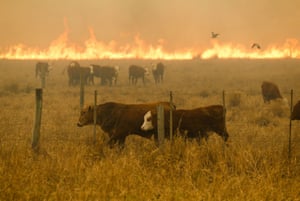
-
Cattle graze against a blazing backdrop in the Chaco region of Paraguay last week
“A total 95% of forest fires are the result of human intervention,” a recent report from the Argentinian government’s national fire management service asserts.
And in Paraguay Luis Recalde, an environmental consultant, says the key causes of the fires are the impact of regional deforestation on the climate, the use of fire to clear land for agriculture and illegal marijuana plantations, and the state’s extremely poor enforcement of environmental laws.
“It’s rare for the rules to be followed,” he says. Paraguay’s wildfires have been concentrated in its Gran Chaco region, which has some of the world’s highest deforestation rates, largely driven by cattle ranching.
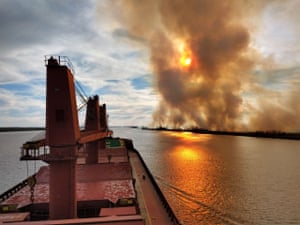
-
Fires in the Parana Delta seen from a cargo ship on the river
The pandemic has further complicated the situation. In Argentina, “the Covid pandemic has reduced the capacity of authorities to act”, says environmental policy researcher Elisabeth Mohle, of the National University of General San Martin in the province of Buenos Aires. “The national parks, for example, were closed down, so they couldn’t control forests and grasslands for early signs of wildfires. Then there’s a tremendous lack of responsibility on the part of producers and landowners, their prevailing logic is to deforest with fire and damn the consequences.”
And in Brazil, since the pandemic began, environmental officials have admitted they have scaled back enforcement operations, while others have been fired and demoted for political reasons.
Meanwhile, Brazil’s far-right populist president, Jair Bolsonaro, told the United Nations general assembly that Brazil is the victim of an international disinformation campaign backed by “shady interests”.
“What we have is authorities that question numbers, question the extent of the fires, question the capacity of satellites to monitor and detect … this ends up directly encouraging those who commit (environmental) crimes,” says Raoni Rajao, coordinator of laboratory for the study of environmental services management at the Federal University of Minas Gerais.
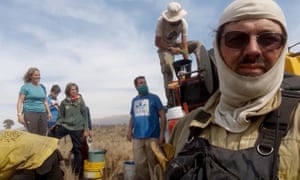
The response to the fires has often been driven by heroic amateurs. Jorge Martini and his group of volunteers, the Cosquin Environmental Brigade, have been battling the recent fires in Argentina. A couple of weeks ago, when they ran out of water near the town of Huerta Grande, they thought they would have to give up, but a group of local people formed a human chain to supply more water.
“They’re filling our tank with buckets, how about that?” a visibly moved Martini says in a video he captured of the event.
The scale of destruction is hard to measure. “We know that in Cordoba some 180,000 hectares (nearly 700 square miles – bigger than Greater London) have burned so far this year, but we don’t have an exact area for the totality of the fires,” says Sandra Torrucio, a scientist monitoring satellite images at Argentina’s space agency.
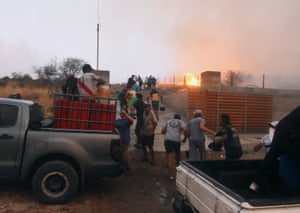
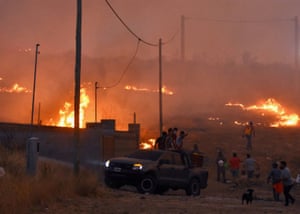
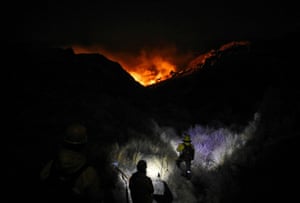
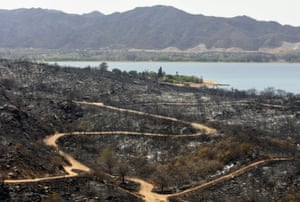
-
Jorge Martini (above) reported people forming a human chain to attempt to stem a blaze in Argentina; elsewhere across the country fires have ravaged the land
But researcher Mohle warns against blaming the producers alone. “There is a lack of climate awareness in general and a failure by the authorities to communicate the gravity of the crisis. The fires in Australia had more coverage in Argentina’s media than the fires in Argentina are having today.”
The damage is affecting the perception of this region. “Each tree that is cut down in the Amazon and each animal burned in the Pantanal transforms Brazil further into an environmental pariah,” says Marcio Astrini, executive secretary of the Climate Observatory, a network of civil society organisations.
But there may be a way forward, suggests Kowalewski. He believes that humans should take a cue from the monkeys he studies. “We are told that individual action is the answer. Individual recycling, individual cutting back on consumption. But the cumulative effect of individual actions is a lie. You’ll never see a monkey defending a tree on its own. Male and female monkeys band together to defend it in groups. Collective action is the identifying characteristic of primates. They’re more cooperative than egotistical.”
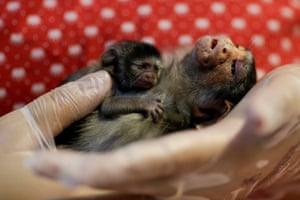
-
Xita, a Rondon’s marmoset, was rescued after giving birth in Porto Velho, Brazil, in August. Vets at the clinic believe the mother and baby were hit by a car as they fled the fires. Xita’s condition is slowly improving, but her baby didn’t make it
Sign up for the Animals farmed monthly update to get a roundup of the best farming and food stories across the world and keep up with our investigations. You can send us your stories and thoughts at animalsfarmed@theguardian.com